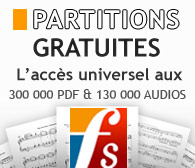| Bach, Johann Sebastian - Coro: "O ewiges Feuer, o Ursprung der Liebe" for Small Orchestra BWV 34 No 1 Vents & Orchestre Cordes |
VoirPDF : Coro: "O ewiges Feuer, o Ursprung der Liebe" (BWV 34 No 1) for Small Orchestra (53 pages - 745.39 Ko)197x⬇ MP3 : Coro: "O ewiges Feuer, o Ursprung der Liebe" (BWV 34 No 1) for Small Orchestra 35x⬇ 144x
| Compositeur : | Bach, Johann Sebastian (1685 - 1750) | ||||
| Instrumentation : | Vents & Orchestre Cordes1 autre version | ||||
| Genre : | Baroque | ||||
| Arrangeur : Editeur : | MAGATAGAN, MICHAEL (1960 - ) | ||||
| Droit d'auteur : | Public Domain | ||||
| Ajoutée par magataganm, 07 Nov 2015 O ewiges Feuer, o Ursprung der Liebe (O eternal fire, o source of love), BWV 34,[a] is a church cantata composed by Johann Sebastian Bach as an adaptation of a previously composed secular cantata, BWV 34a. This piece reached its current form in Leipzig in 1740 or by 1746 for the first day of Pentecost. The date of the work's premiere is unknown, but it certainly took place in or before 1746. The opening chorus presents the image of eternal heavenly flame. The instrumental ritornello comprises a sustained trumpet entry, active strings, and "flickering" oboes, drums, and trumpets. Unlike in most da capo movements, this ritornello appears only at the beginning and end. Each voice enters on a long note, imitating the trumpet and presenting the notion of "eternal Divine Love shining through the ongoing flames of consecration". The middle section develops these themes in minor keys before the ritornello returns to reprise the A section. The two recitatives (the second and fourth movements, for tenor and bass respectively) are quite similar in character: they adopt an authoritative tone, are in minor mode, and begin with a bass pedal. The alto aria conveys images of contentment by incorporating a lilting berceuse-like rhythm, with violin obbligato and flute in tenths and octaves. It is accompanied by a tonic pedal in the continuo. The aria is in adapted ternary form. The closing chorus adopts the end of the bass recitative as its introduction. The violins and oboes then play an ascending figure to introduce the new melody. The movement is structured as a 12-bar instrumental section, repeated with choir, followed by a 31-bar instrumental section, repeated with choir. The piece is scored for three vocal soloists (alto, tenor, bass) and four-part choir, two oboes, two flauti traversi, timpani (tamburi), three trombe in D, two violins, viola, and basso continuo. Source: Wikipedia (https://en.wikipedia.org/wiki/O_ewiges_Feuer,_o_Urspru ng_der_Liebe,_BWV_34). I created this arrangement of the opening coro: "O ewiges Feuer, o Ursprung der Liebe" (O eternal fire, o source of love) for Small Orchestra (Piccolo Trumpet in Bb, Bb Trumpet, Flugelhorn, Flute, Oboe, Bb Clarinet, English Horn, French Horn, Bassoon, Timpani, 2 Violins, Viola, Cello & Contrabass). Partition centrale : | O ewiges Feuer, o Ursprung der Liebe (7 partitions) | | |||
© 2000 - 2024
Accueil - Nouveautés - Compositeurs
Mentions légales - Version intégrale








